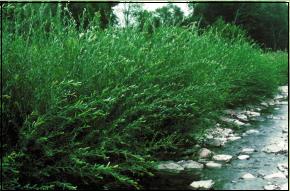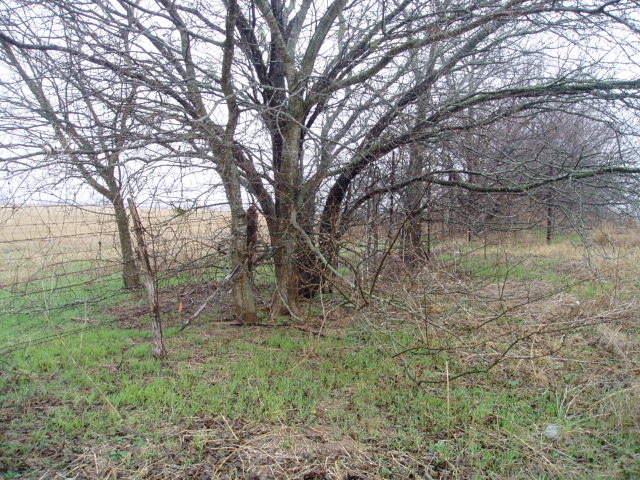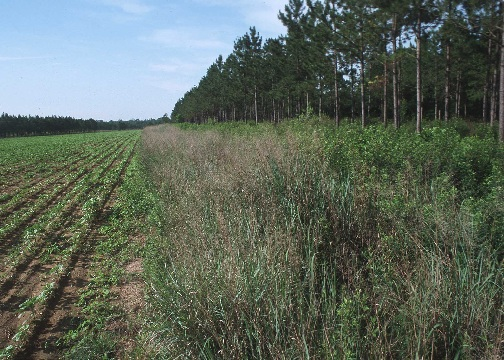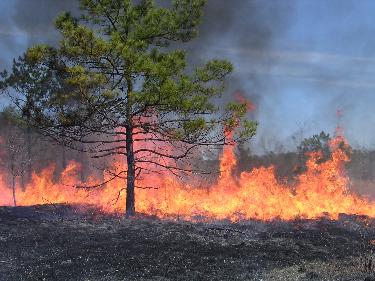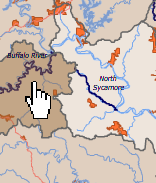 | The NRCS Electronic Field Office Guide (e-FOTG) provides writtin descriptions, standards, specification guides and job sheets for approved practices. This data is also available at http://www.nrcs.usda.gov/technical/eFOTG/ |
Buffers For Nutrient Management and Erosion Control
Contour Buffer Strips | Description: Narrow strips of permanent, herbaceous vegetative cover established across the slope and alternated down the slope with parallel, wider cropped strips. Benefits: To reduce sheet and rill erosion, to reduce transport of sediment and other water-borne contaminants downslope, onsite or off-site, and to to enhance wildlife habitat Possible Funding: CSP, Continuous CRP NRCS Practice Standard (NRCS link) |
| Description: A strip or area of herbaceous vegetation situated between cropland, grazing land, or disturbed land (including forestland) and environmentally sensitive areas. Possible Funding: EQIP, CSP, Continuous CRP NRCS Practice Standard (NRCS link) |
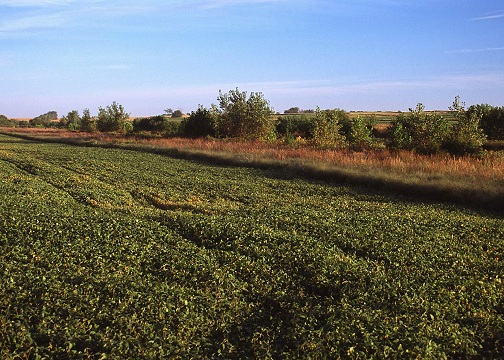 Field Border NRCS Code-386 | Description: A strip of permanent vegetation established at the edge or around the perimeter of a field. Benefits: Reduce erosion from wind and water, soil and water quality protection, management of harmful insect populations, provide wildlife food and cover, increase carbon storage in biomass and soils, and improve air quality. Possible Funding: EQIP, CSP, Continuous CRP NRCS Practice Standard (NRCS link) |
| Description: A natural or constructed channel that is shaped Benefits: To convey runoff from terraces, diversions, or other water concentrations without causing erosion or flooding, to reduce gully erosion, and to protect/improve water quality. Possible Funding: EQIP, CSP, Continuous CRP NRCS Practice Standard (NRCS link) |
| Description: Windbreaks or shelterbelts are single or multiple rows of trees or shrubs in linear configurations. Benefits: Reduce soil erosion from wind, protect plants from wind related damage, alter the microenvironment for enhancing plant growth, manage snow deposition, provide shelter for structures, animals, and people, enhance wildlife habitat, provide noise screens, provide visual screens, improve air quality by reducing and intercepting air borne particulate matter, chemicals, and odors, delineate property and field boundaries, improve irrigation efficiency, and increase carbon storage in biomass and soils. Possible Funding: CSP, Continuous CRP Fact Sheet Windbreak/Shelterbelt Establishment NRCS Practice Standard (NRCS link) |
| Description: Replacing, releasing, and/or removing selected trees and shrubs or rows within an existing windbreak or shelterbelt, adding rows to the windbreak or shelterbelt, or removing selected tree and shrub branches... Benefits: Restoring or enhancing the original planned function of existing windbreaks or shelterbelts. Possible Funding: CSP, Continuous CRP NRCS Practice Standard (NRCS link) |
| Description: Establishment of dense vegetation composed of shrubs and/or trees in a linear design in, across, or around a field to achieve a natural resource conservation purpose. Benefits:To provide at least one of the following conservation functions: food, cover and corridors for terrestrial wildlife, food and cover for aquatic organisms that live in watercourses with bank-full width less than 5 feet, to intercept airborne particulate matter, to reduce chemical drift and odor movement, to increase carbon storage in biomass and soils, living fences, boundary delineation, contour guidelines, screens and barriers to noise and dust, and improvement of landscape appearance NRCS Practice Standard (NRCS link) |
Pasture and Hay Management
| Description: Establishing native or introduced forage species. Benefits: Establish adapted and compatible species, Possible Funding: EQIP NRCS Practice Standard (NRCS link) |
| Description: Controlled fire applied to a predetermined area. Benefits: Control undesirable vegetation, prepare sites for harvesting, planting or seeding, control plant disease, reduce wildfire hazards, improve wildlife habita, improve plant production quantity and/or quality, remove slash and debris, enhance seed and seedling production, facilitate distribution of grazing and browsing animals, and restore and maintain ecological sites. Possible Funding: WHIP, EQIP, CSP, Continuous CRP Fact Sheet: Prescribed Burning NRCS Practice Standard (NRCS link) |
Prescribed Grazing NRCS Code 528 | Description: Managing the controlled harvest of vegetation primarily with grazing and/or browsing animals. Benefits: Improve or maintain the health and vigor of plant communities, improve or maintain the availability of quality forage for livestock health and productivity, improve or maintain water quality and quantity, reduce accelerated soil erosion, and maintain or improve soil condition, improve or maintain the quantity and quality of food and/or cover available for wildlife through increased diversity and health of plant composition, and promote economic stability through grazing land sustainability and increased harvest efficiency and utilization. Possible Funding: EQIP, WHIP, Continuous CRP NRCS Fact Sheet - Prescribed Grazing NRCS Practice Standard (NRCS link) |
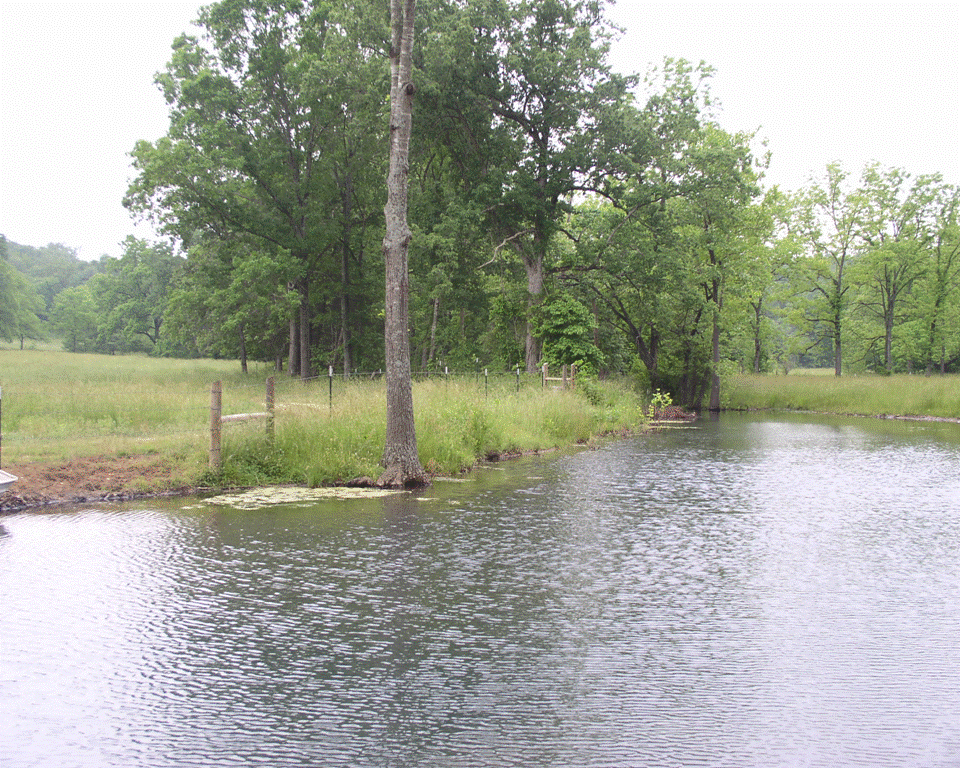 Fence NRCS Code 382 | Description: A constructed barrier to livestock, wildlife or people. Benefits: This practice may be applied as part of a conservation management system to facilitate the application of conservation practices that treat the soil, water, air, plant animal and human resource concerns. Possible Funding: EQIP, WHIP, Continuous CRP NRCS Practice Standard (NRCS link) |
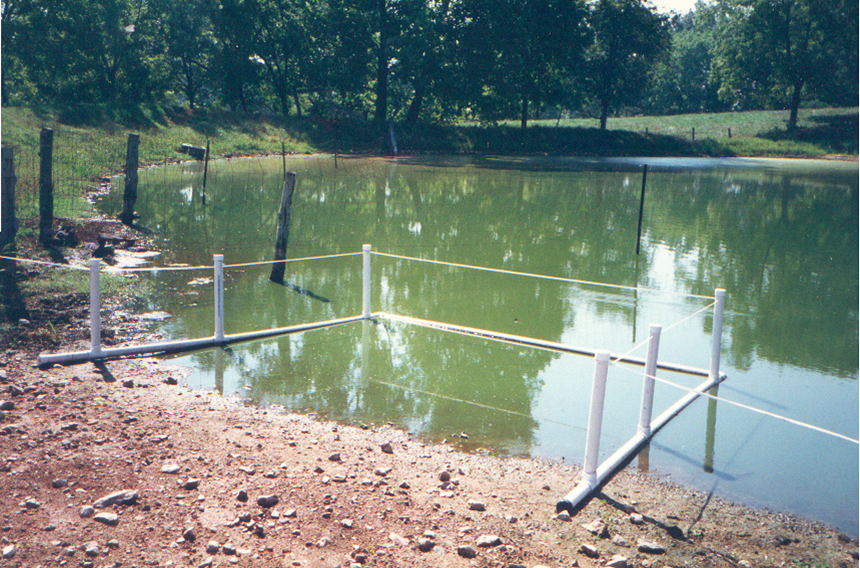 Pond NRCS Code 378 | Description: A water impoundment made by constructing a dam or an embankment or by excavating a pit or dugout. In this standard, ponds constructed by the first method are referred to as embankment ponds, and those constructed by the second method are referred to as excavated ponds. Ponds constructed by both the excavation and the embankment methods are classified as embankment ponds if the depth of water impounded against the embankment at spillway elevation is 3 ft or more. Benefits: To provide erosion control, water for livestock, fish and wildlife, recreation, fire control, crop and orchard spraying, and other related uses, and to maintain or improve water quality. Possible Funding: EQIP NRCS Practice Standard (NRCS link) |
| Description: Protecting heavily used areas by establishing vegetative cover, by surfacing with suitable materials, or by installing needed structures. Benefits: To stabilize urban, recreation, or facility areas Possible Funding: EQIP NRCS Practice Standard (NRCS link) |
| Description: Collection of water from springs or seeps to provide water for a conservation need. Benefits: Improve the quantity and/or quality of water for livestock, wildlife or other agricultural uses. Possible Funding: EQIP NRCS Practice Standard (NRCS link) |
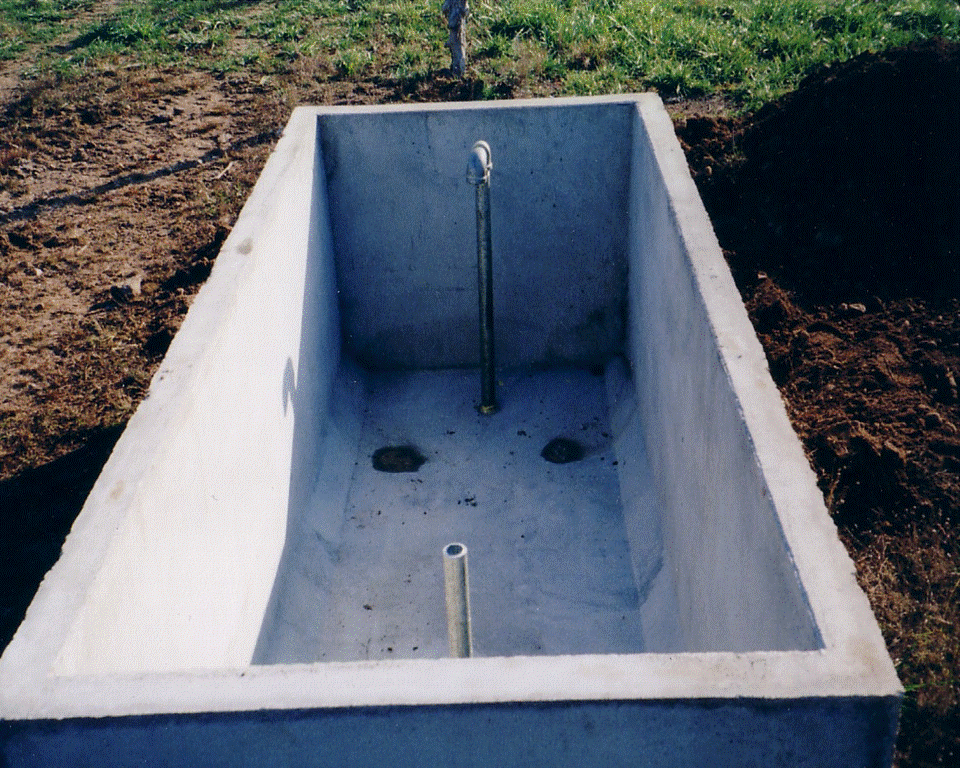 Watering Facility NRCS Code 614 | Description: A device (tank, trough, or other watertight Benefits: protect and enhance vegetative cover through proper distribution of grazing, provide erosion control through better grassland management, or protect streams, ponds and water supplies from contamination by providing alternative access to water. Possible Funding: EQIP, Continuous CRP, WHIP, CSP NRCS Practice Standard (NRCS link) |
Use Exclusion NRCS Code 472 | Description: Excluding animals, people or vehicles from an area. Budget: To prevent, restrict, or control access to an area to maintain or improve the quantity and quality of resources, e.g., road and trail closure, seasonal or permanent livestock exclusion, wildlife exclusion and to prevent, restrict, or control access to an area to minimize human health, liability, and safety concerns, e.g., recreational access, trespass, safety zones. NRCS Practice Standard (NRCS link) |
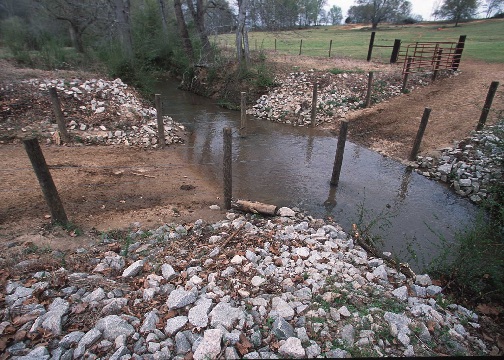 Stream Crossing NRCS Code-578 | Description: A stabilized area or structure constructed across a stream to provide a travel way for people, livestock, equipment, or vehicles. Benefits: Improve water quality by reducing sediment, nutrient, organic, and inorganic loading of the stream, reduce streambank and streambed erosion, and provide crossing for access to another land unit. Possible Funding: EQIP Fact Sheet - Stream Crossings NRCS Practice Standard (NRCS Link) |
319 Program Agricultural Best Management Practices (Word Document)
Practices differ from financial assistance programs. Some programs, such as the Environmental Quality Improvement Program (EQIP), provide cost share for a single practice. Other programs, such as the Conservation Reserve Program (CRP) and Wildlife Habitat Improvement Program (WHIP), identify a resource need and then use a "package" of practices designed to address the landowner's unique resource need. Eligibility, landowner obligations, and financial assistance available differ for each program. Below you will find eight continuous CRP objectives, identified by CP and a number, that address different habitat-related resource needs. You will find an illustrative list of practices for each one. The practice lists are not exhaustive and will not be appropriate for all situations. Specific practices used will depend on each landowner's specific situation.
USDA Natural Resources Conservation Service (NRCS) maintains practice standards, specifications, job sheets and maintenance/operation requirements developed for Arkansas. Priority needs and practices are reviewed annually by the Arkansas State Technical Committee and updated as needed. The links below will take you to the most recently updated practice standards, specifications and job sheets in the electronic Field Office Technical Guide (e-FOTG).
Photo Credits
Fulton County Conservation District, USDA Natural Resources Conservation Service, Multi-Agency Wetlands Planning Team, The Nature Conservancy, Arkansas Chapter, City of Rogers, Arkansas Game & Fish Commission, Ecological Conservation Organization, Arkansas Natural Heritage Commission, Restoring America's Wetlands, Arkansas Parks & Tourism Department, U.S. Fish & Wildlife Service, Ducks Unlimited, U.S. Geological Survey, Texas A&M University, Purdue University-Fort Wayne, Kansas Department of Forestry, Virginia Tech Cooperative Extension Service


